The airplane entered the world only a few years before Dreadnought, but its immediate impact was much smaller. The slow, short-ranged aircraft of the first decade of heavier-than-air flight were incapable of meaningful contribution to naval warfare. However, this was to change radically over the next few decades, and navies were not slow to realize this.
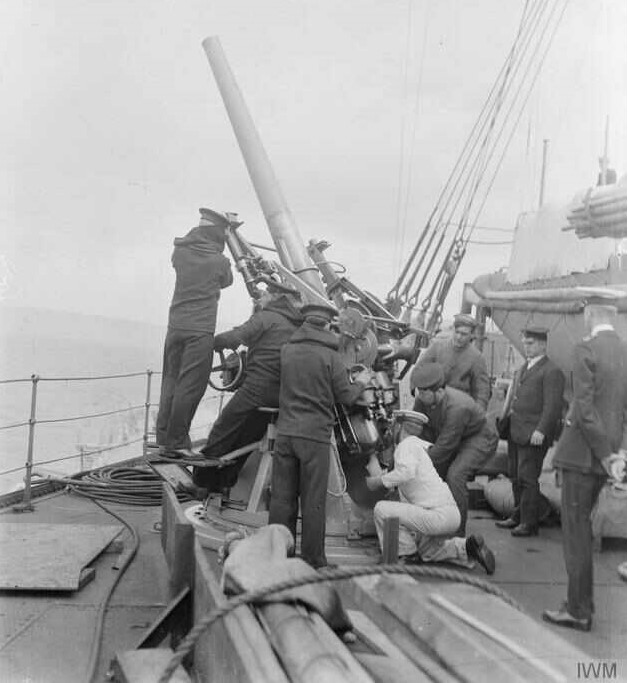
QF 3" 20 cwt onboard HMS Royal Oak
The first battleships to carry AA guns were the British Iron Dukes, who received a pair of 3"/45 guns upon completion in 1913. These weapons were mounted in open high-angle mountings, designed exclusively for AA fire. They proved to be excellent weapons, well-suited to the demands of shooting at aircraft, a very different challenge from the usual problems of surface gunnery. Airplanes were small and fragile, but moved much more quickly than surface ships, and in three dimensions. This meant that the most prized features in AA weapons were handiness, so that the gun could be brought on target quickly and kept there, and a high rate of fire.1 Time fuzes were used to make the shells explode near the predicted target position, greatly increasing the lethal area, but the target could maneuver while the shell was in flight, so a high muzzle velocity was also desired. However, this required a long barrel, so larger-caliber weapons tended to be short and low-velocity.2
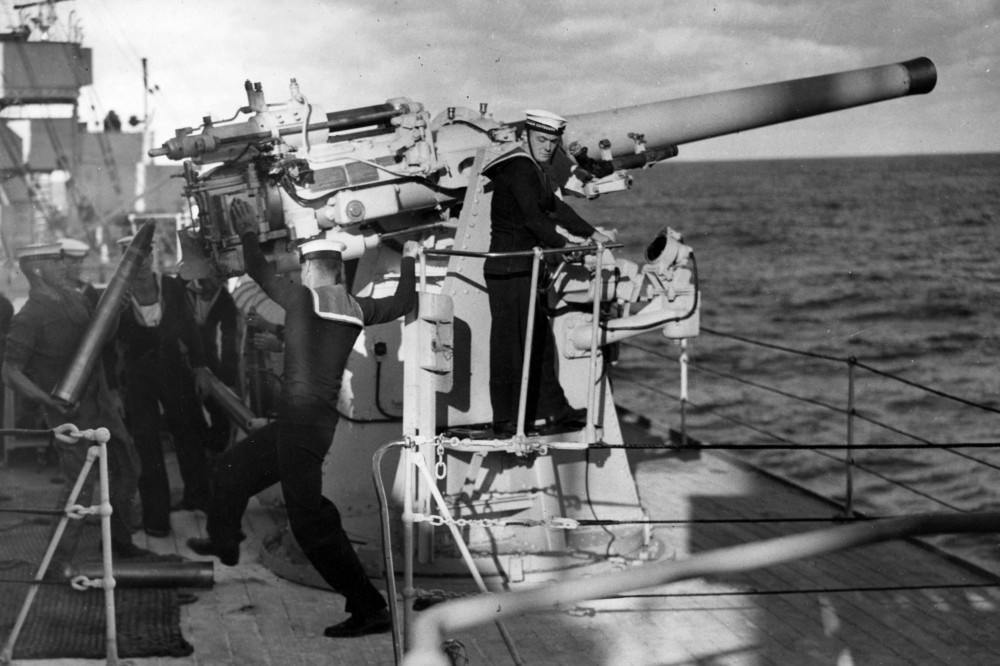
QF 4 inch Mk V gun
During the early stages of the war, the major threat was from zeppelins, not fixed-wing airplanes. The Royal Navy was assigned responsibility for defending the UK against zeppelins as an extension of its traditional role as the shield of the homeland, and while all of the battleships of the Grand Fleet had a pair of AA guns by November 1914, some were subsequently dismounted to strengthen the defenses of London. Nor were zeppelins only a threat to London. While neither lighter-than-air nor heavier-than-air aircraft were a direct threat to the battleships, reconnaissance aircraft were a potential problem, and 4" and 6" AA guns were soon placed in service to attack them, as 3" guns had insufficient range. While the 4" gun proved a useful weapon, although notably less handy than the 3",3 the 6" projectiles were too heavy to load quickly at high angles, particularly without power ramming. By the end of the war, it was not uncommon to see 4 4" AA guns aboard a British battleship, and the latest destroyers even had a 3" AA gun.
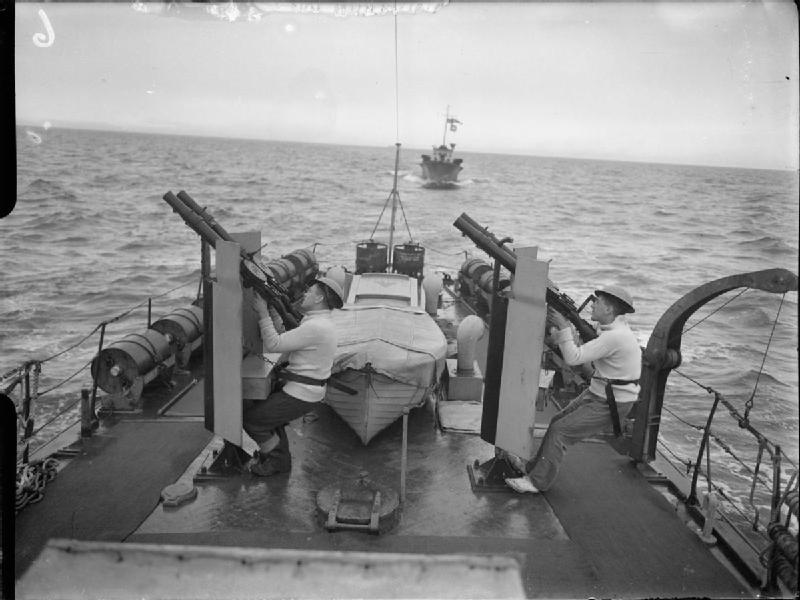
Lewis Guns aboard an RN destroyer
However, while these guns were reasonably effective, they had limitations. Even the fastest fired no more than 20 rounds/minute, and couldn't train fast enough to keep up with airplanes at close range. The obvious solution was an automatic weapon, and the British quickly began to install machine guns, although their numbers were initially limited by the demands of the Western Front. As the war progressed, and strafing aircraft and torpedo attack became concerns, battleships were given an armament of 10 Lewis Guns. These weapons were supplemented, particularly on smaller ships, by 1 pdr and 2 pdr Pom-Poms, so known from the "pom-pom" noise they made while firing.4 These weapons, mounted singly and aimed with basic ring sights, were mostly intended for smaller ships, which had more to fear from air attack and didn't mount heavy AA guns. Some were installed on battleships, a decision at least partially intended to provide protection against small boats in coastal waters.5 As a stopgap, many existing weapons, such as the QF 3 and 6 pdrs, were fitted on new mountings to allow high-angle fire.
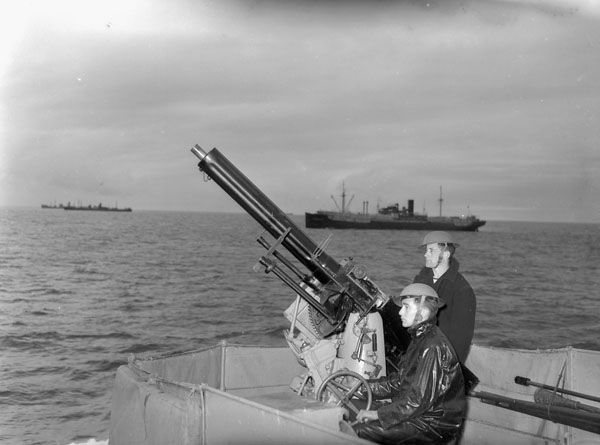
QF 2 pdr
Other navies followed suit, fitting guns of similar size to the British. The USN chose not to develop a 4" gun, and instead had 8 3"/50s on its ships. These weapons were hand-operated, for reliability and because power operation of such mounts wasn't practical, and they were essentially just bolted to the deck. As such, outfits tended to change frequently. Fire control during the war years was primitive, with basic mechanical aids to assist the gun crew in setting fuzes based on their visual estimates of what the target was doing. These were not particularly successful, and as an alternative to aiming directly at the airplane, barrage fire was developed. This involved picking a box in the sky that the target would fly through, and filling it with shells. If the plane made it through the box unscathed, another was selected in front of it, and the process repeated. This method also had the useful property of forcing the pilot to fly through a cloud of shellbursts, which most aviators were understandably reluctant to do. In practice, the deterrent effect of naval AA guns was significantly more important than their actual ability to shoot down planes.
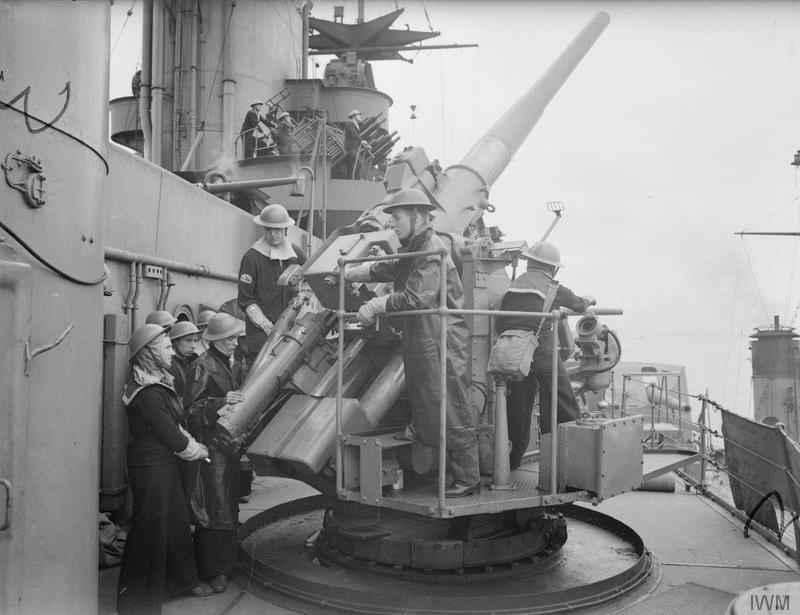
QF 4.7 inch Mk VIII gun aboard HMS Rodney
The British in particular were interested in barrage fire from their heavy guns, and many interwar guns, up to and including the main batteries of their 8" cruisers, had some high-elevation capability, usually up to about 60°, to support this. Unfortunately, improved airplane performance meant that this was mostly irrelevant by the time World War II broke out.
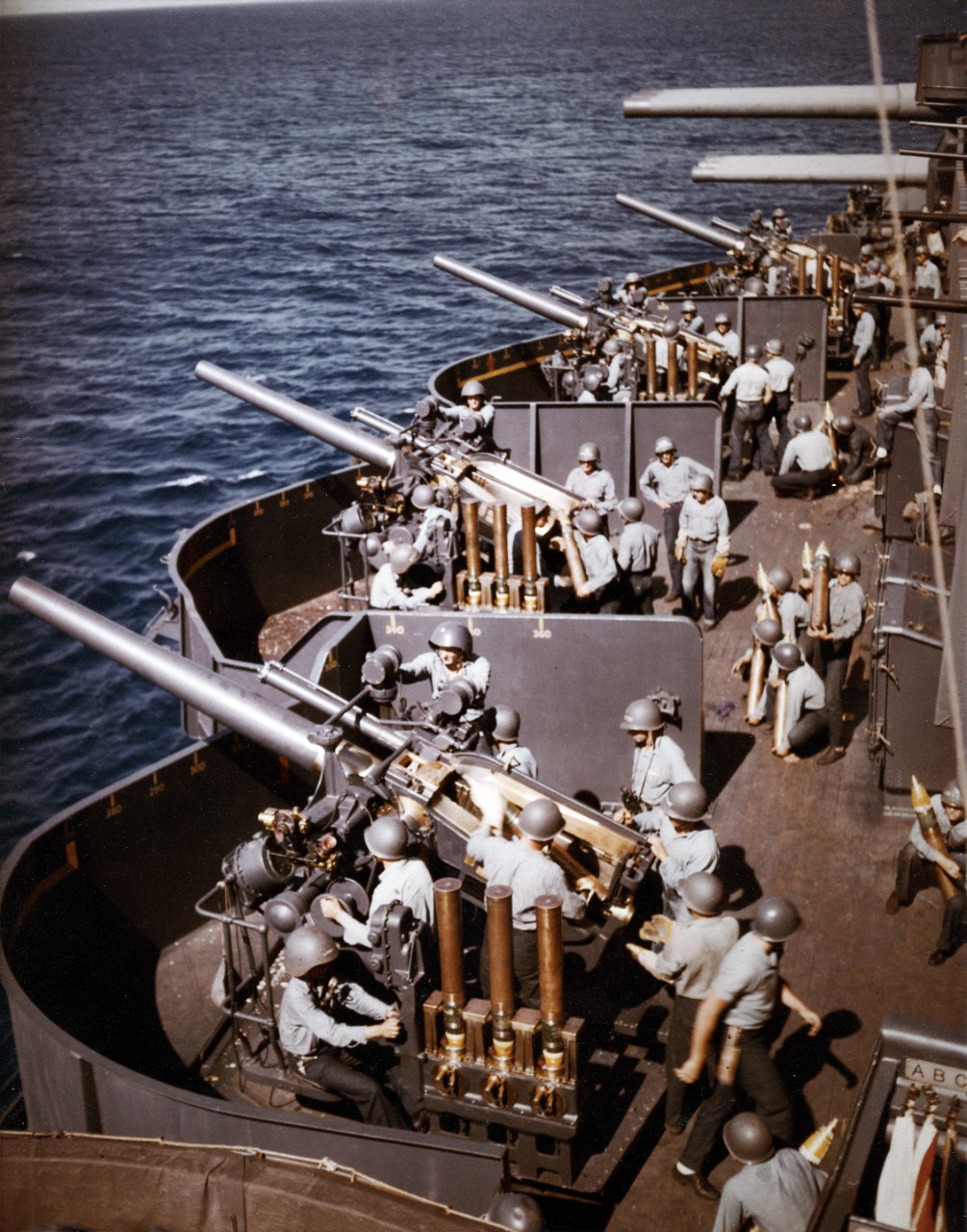
5"/25s on New Mexico. Note the shells nose-down in the fuze setters beside each gun
In the years after the Armistice, navies began to develop larger AA guns. The British introduced a 4.7"/40 gun, while the US built a 5"/25. These were about the largest guns that could be usefully worked by hand, although the British found that the absence of power ramming on the 4.7" limited rate of fire thanks to the 80-lb fixed rounds. The USN did fit its guns with power ramming, and the 5"/25 proved to be a useful weapon. The battleships and cruisers of the interwar era were fitted with them, and they even found some use in the anti-surface role. Navies continued to fit automatic weapons for close-range work, too, most often some form of .50 cal machine guns.
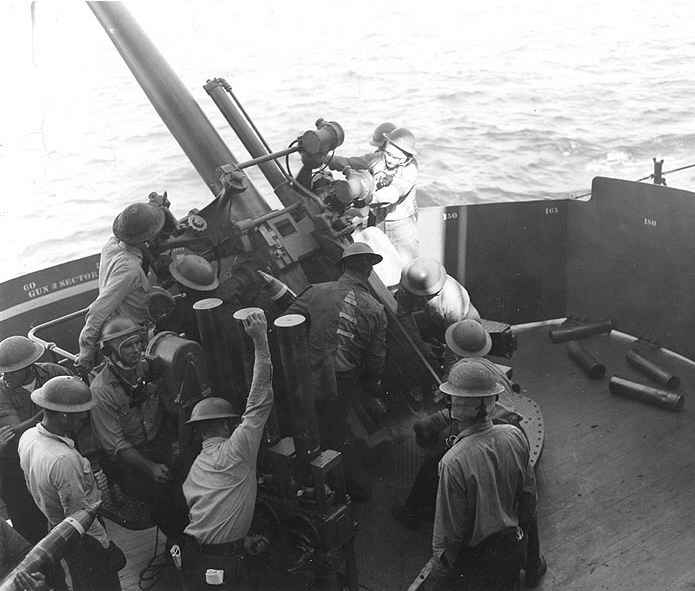
A crew training with a 5"/25 aboard Astoria
The anti-air and anti-surface secondary batteries were kept separate by the demand for hand-operated guns. The 5"/25, for instance, had a muzzle velocity of 2,155 ft/s, while the 5"/51 could reach 3,150 ft/s, but it also had only a third of the rotational inertia of the longer gun, allowing it to track quickly. For the barrage tactics common at the time, the low muzzle velocity was not a significant drawback, but it would have greatly reduced accuracy against surface targets.6 Rate of fire would suffer at low angles. The breech needed to be at a comfortable height above the deck for the operator to load quickly, and as the gun depressed, a breech positioned for comfortable loading at high angles could be uncomfortably high. This could be solved by moving the trunions, the pins around which the gun elevated, backwards, but this unbalanced the gun and reduced elevation rate. Another issue was that the trunions had to be high enough that the gun would not strike the deck below it even at full recoil. The British attempted to solve this problem by surrounding the gun with a trench in the deck, which was covered by plates when the gun was firing at low angles. It worked, but not brilliantly, and the problem was ultimately solved by the use of power to elevate the guns, which allowed the trunions to be moved back.
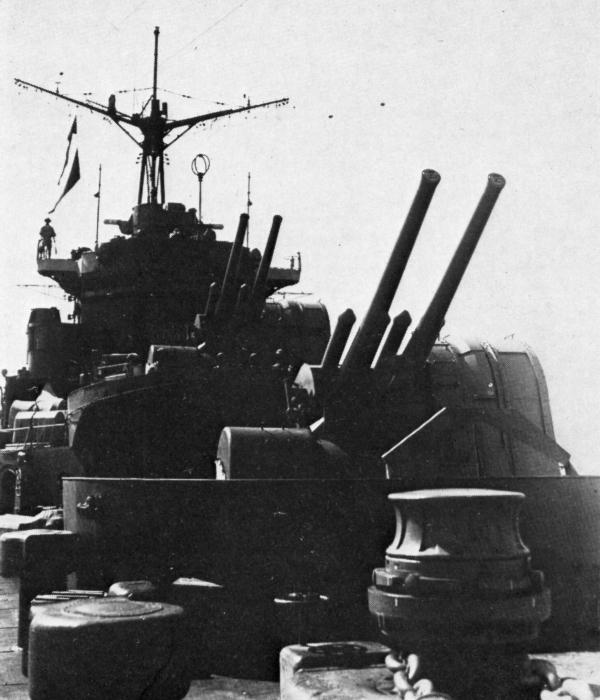
Japanese 12.7 cm guns on seaplane carrier Chitose
The adoption of power-worked mountings allowed most designers to discard separate anti-air and anti-surface batteries by the start of World War II. The only holdouts were Japan and Germany, who used 12.7 cm and 10.5 cm AA guns respectively on their battleships. Both had at least some anti-surface capability, but were overshadowed in that role by the much larger low-angle guns that were also mounted. Next time, we'll examine the rise of the dual-purpose secondary gun, and how it shaped the ships that fought WWII.
1 The 3"/45 had a range of about 6,500 yds and could fire 15-22 rounds/minute. ⇑
2 I intend to talk about AA fire control at some length, but today I'm going to focus on the weapons themselves and their integration with ship design. ⇑
3 On a few ships, the 3" was used instead of the 4" because the gun was also supposed to be used against submarines spotted close by, and the 4" would take too long to get on target. ⇑
4 The WWI 2 pdr was the ancestor of the famous WWII 2-pdr Pom-Pom, not the same weapon. ⇑
5 The Germans made use of remote-controlled motorboats loaded with explosives, intending to ram them into ships and destroy them that way. They weren't particularly successful, but did cause the British to take countermeasures. ⇑
6 This is due to our old friend danger space. At 6,000 yards, the 5"/51 had a danger space of 96 yds, while the 5"/25's was only 36 yds. This excluded the area of the deck, which would be a relative improvement to the shorter gun (how big depends on the aspect of the target), but it does show the advantage of high muzzle velocity for surface fire. ⇑

Recent Comments